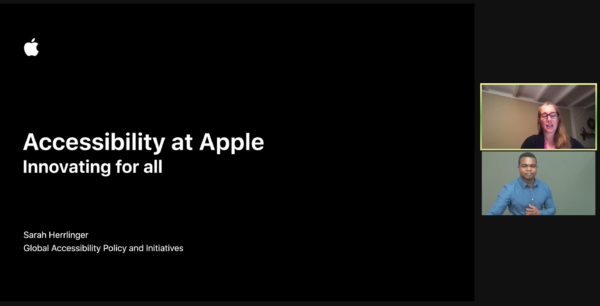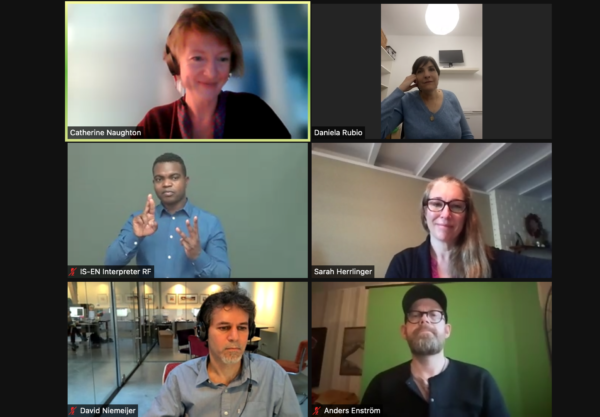On 12 October 2021, the European Disability Forum (EDF) organised an online event, with the support of Apple, where our members listened to perspectives on how equal access to technology can support more inclusive education – from technology providers, developers, educators, and schools. Contributions led to a fruitful discussion on the power of accessible technology as a fundamental tool in the educational growth of students with disabilities.
The event was opened by Sarah Herrlinger, Senior Director of Global Accessibility Policy & Initiatives at Apple. Ms Herrlinger recalled the powerful benefits that technology can provide, when accessibility is implemented from the outset and across a coherent ecosystem, in which products and software are designed for all.
This holistic way of working allows Apple to build a wealth of accessibility features that are built into all of their products and can support a wide breadth of user needs.
Ms Herrlinger closed her speech by highlighting Apple’s continued support for Europe Code Week, a grassroots initiative for digital literacy that is supported by the European Commission and runs annually in October. For this year’s edition, Apple created ‘Inclusive App Design’ resources for educators and students. Through this activity, students are encouraged to come up with an app idea for a topic they care about, then discover how to develop it with inclusion and accessibility at the heart of their app design. This also allows more students to understand the importance of accessibility in coding, whilst generating better understanding and support for students with disabilities across the globe.
Following these opening remarks, EDF Director Catherine Naughton moderated the discussion with three panelists: David Niemeijer, founder and CEO of AssistiveWare; Daniela Rubio, consultant in digital accessibility, and Anders Enström, educator at the Skapaskolan school in Sweden
Ms Rubio started the discussion by highlighting the barriers that technology can help overcome between educators and students. She also gave the attendees an example of the collaboration that shared documents can facilitate. This type of tool has helped educators, especially during the pandemic, as students who were not able to go to school could follow the documents in real-time and in an accessible manner.
Ms Rubio ended her intervention by stressing the importance of personalisation, especially for students with disabilities. The technology allows the information to be displayed clearly according to the student’s needs.
Mr Niemeijer, Founder and CEO of AssistiveWare then referred to the progress made in assistive technology and accessibility features in mainstream products. All operating systems include accessibility features so according to Mr Niemeijer barriers come from outside of technology. In this regard, he underlined four main barriers:
- Outdated beliefs: Many educators don’t believe in the potential of their students with disabilities.
- Lack of funding: Schools often lack the budget to purchase the technology and make it available for all students.
- Lack of knowledge: It is not enough that the technology is in the student’s hands but that there is knowledge of the potential of that technology and
- Lack of collaboration between schools and families: Often not taking a shared responsibility to make sure the student has the access all the time.
To conclude, Mr Niemeijer stated that in order to narrow the gap in the use of technology the most important aspect is to think about how educators need to change their practices. To achieve this, educators need time and ongoing support to adjust and make use of technology in the classroom.
Anders Enström, an educator from the Skapaskolan school in Sweden, closed the panel discussion by addressing the accessibility features and solutions found in his work. To make an inclusive classroom, he uses different tools that allow students to be prepared before going to class. He also pointed out that students need to be educated and develop the solution that suits them best.
Mr Enström stressed the importance of funding for students to have access to technology, as well as the role of creativity in the classroom.
Event participants were able to ask questions, including, among others, the barriers that inaccessible content pose to children with disabilities, even if the technologies they use are accessible. There was also a call to ensure that text to speech technologies are available for small languages too.
The conference was closed by Ms Naughton who thanked all the speakers and attendees for participating in the discussion, and highlighted that teaching will transform how technology is designed, but also how much more is still needed.
Resources mentioned during discussions:
- Apple & Accessibility Webpage
- Apple’s Inclusive App Design Resources for Europe Code Week
- This Is Not About Me Documentary, supported by AssistiveWare
Photos of the event

